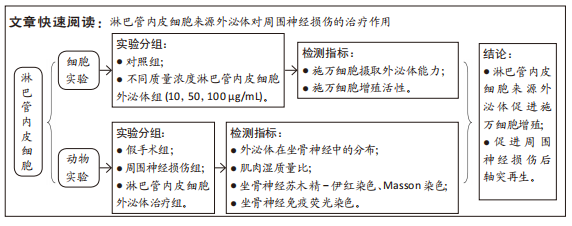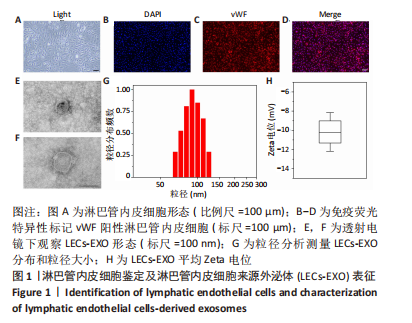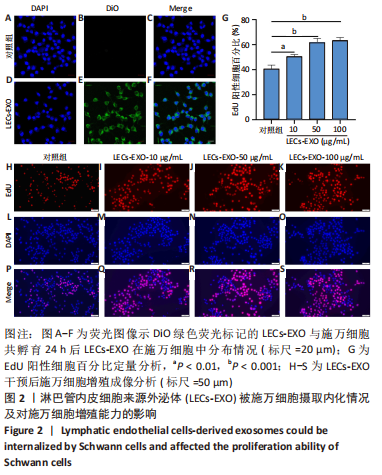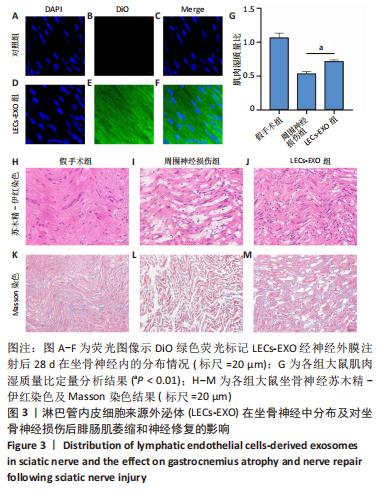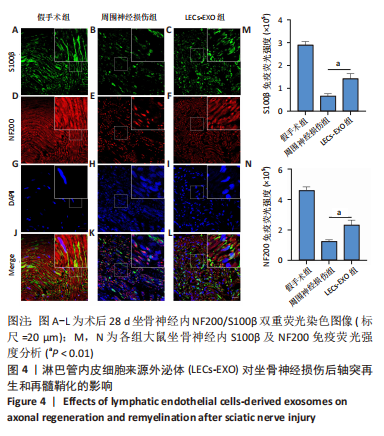[1] 陈焱,肖志宏,邢丹谋.周围神经损伤再生与修复的研究进展[J].中华显微外科杂志,2015,38(4):413-416.
[2] OLIVER G, KIPNIS J, RANDOLPH GJ, et al. The Lymphatic Vasculature in the 21(st) Century: Novel Functional Roles in Homeostasis and Disease. Cell. 2020;182:270-296.
[3] BOUVRÉE K, BRUNET I, DEL TORO R, et al. Semaphorin3A, Neuropilin-1, and PlexinA1 are required for lymphatic valve formation. Circ Res. 2012;111:437-445.
[4] FRUEH FS, GOUSOPOULOS E, POWER DM, et al. A potential role of lymphangiogenesis for peripheral nerve injury and regeneration. Med Hypotheses. 2020;135:109470.
[5] KALLURI R, LEBLEU VS. The biology, function, and biomedical applications of exosomes. Science. 2020;367(6478):eaau6977.
[6] MITTELBRUNN M, SÁNCHEZ-MADRID F. Intercellular communication: diverse structures for exchange of genetic information. Nat Rev Mol Cell Biol. 2012;13:328-335.
[7] 袁一鸣,王艳,陈程程,等.外泌体在周围神经损伤进程中的效应[J].中国组织工程研究,2020,24(31):5079-5084.
[8] JALKANEN S, SALMI M. Lymphatic endothelial cells of the lymph node. Nat Rev Immunol. 2020;20:566-578.
[9] 裴福兴,王光林,林卫.周围神经损伤后免疫反应与神经再生的研究进展[J].中华显微外科杂志,1997,20(2):80-82.
[10] PETROVA TV, KOH GY. Biological functions of lymphatic vessels. Science. 2020;369(6500):eaax4063.
[11] JACOB L, BOISSERAND LSB, GERALDO LHM, et al. Anatomy and function of the vertebral column lymphatic network in mice. Nat Commun. 2019;10:4594.
[12] VOLPI N, AGLIANÒ M, MASSAI L, et al. Lymphatic vessels in human sural nerve: immunohistochemical detection by D2-40. Lymphology. 2006;39:171-173.
[13] LIM AH, SULI A, YANIV K, et al. Motoneurons are essential for vascular pathfinding. Development. 2011;138:3847-3857.
[14] TAKAMATSU H, TAKEGAHARA N, NAKAGAWA Y, et al. Semaphorins guide the entry of dendritic cells into the lymphatics by activating myosin II. Nat Immunol. 2010;11:594-600.
[15] HROMADA C, HARTMANN J, OESTERREICHER J, et al. Occurrence of Lymphangiogenesis in Peripheral Nerve Autografts Contrasts Schwann Cell-Induced Apoptosis of Lymphatic Endothelial Cells In Vitro. Biomolecules. 2022;12(6):820.
[16] EKSTRÖM K, VALADI H, SJÖSTRAND M, et al. Characterization of mRNA and microRNA in human mast cell-derived exosomes and their transfer to other mast cells and blood CD34 progenitor cells. J Extracell Vesicles. 2012;1:10.
[17] LOPEZ-VERRILLI MA, CAVIEDES A, CABRERA A, et al. Mesenchymal stem cell-derived exosomes from different sources selectively promote neuritic outgrowth. Neuroscience. 2016;320:129-139.
[18] LI C, LI X, SHI Z, et al. Exosomes from LPS-preconditioned bone marrow MSCs accelerated peripheral nerve regeneration via M2 macrophage polarization: Involvement of TSG-6/NF-κB/NLRP3 signaling pathway. Exp Neurol. 2022;356:114139.
[19] LOPEZ-LEAL R, COURT FA. Schwann Cell Exosomes Mediate Neuron-Glia Communication and Enhance Axonal Regeneration. Cell Mol Neurobiol. 2016;36:429-436.
[20] LIU YP, YANG YD, MOU FF, et al. Exosome-Mediated miR-21 Was Involved in the Promotion of Structural and Functional Recovery Effect Produced by Electroacupuncture in Sciatic Nerve Injury. Oxid Med Cell Longev. 2022;2022:7530102.
[21] ZHAN C, MA CB, YUAN HM, et al. Macrophage-derived microvesicles promote proliferation and migration of Schwann cell on peripheral nerve repair. Biochem Biophys Res Commun. 2015;468:343-348.
[22] GAO B, ZHOU S, SUN C, et al. Brain Endothelial Cell-Derived Exosomes Induce Neuroplasticity in Rats with Ischemia/Reperfusion Injury. ACS Chem Neurosci. 2020;11:2201-2213.
[23] ZHANG YZ, LIU F, SONG CG, et al. Exosomes derived from human umbilical vein endothelial cells promote neural stem cell expansion while maintain their stemness in culture. Biochem Biophys Res Commun. 2018;495:892-898.
[24] JIANG Y, XIE H, TU W, et al. Exosomes secreted by HUVECs attenuate hypoxia/reoxygenation-induced apoptosis in neural cells by suppressing miR-21-3p. Am J Transl Res. 2018;10:3529-3541.
[25] LI R, LI D, WU C, et al. Nerve growth factor activates autophagy in Schwann cells to enhance myelin debris clearance and to expedite nerve regeneration. Theranostics. 2020;10:1649-1677.
[26] CARR L, PARKINSON DB, DUN XP. Expression patterns of Slit and Robo family members in adult mouse spinal cord and peripheral nervous system. PLoS One. 2017;12:e0172736.
[27] JOHNSTON AP, YUZWA SA, CARR MJ, et al. Dedifferentiated Schwann Cell Precursors Secreting Paracrine Factors Are Required for Regeneration of the Mammalian Digit Tip. Cell Stem Cell. 2016;19:433-448.
[28] JONES RE, SALHOTRA A, ROBERTSON KS, et al. Skeletal Stem Cell-Schwann Cell Circuitry in Mandibular Repair. Cell Rep. 2019;28:2757-2766.e5.
[29] PARFEJEVS V, DEBBACHE J, SHAKHOVA O, et al. Injury-activated glial cells promote wound healing of the adult skin in mice. Nat Commun. 2018;9:236.
[30] MIN Q, PARKINSON DB, DUN XP. Migrating Schwann cells direct axon regeneration within the peripheral nerve bridge. Glia. 2021;69:235-254.
[31] HANWRIGHT PJ, QIU C, RATH J, et al. Sustained IGF-1 delivery ameliorates effects of chronic denervation and improves functional recovery after peripheral nerve injury and repair. Biomaterials. 2022; 280:121244.
[32] ZOCHODNE DW. The challenges and beauty of peripheral nerve regrowth. J Peripher Nerv Syst. 2012;17:1-18.
[33] SCHEIB J, HÖKE A. Advances in peripheral nerve regeneration. Nat Rev Neurol. 2013;9:668-676.
[34] JESSEN KR, ARTHUR-FARRAJ P. Repair Schwann cell update: Adaptive reprogramming, EMT, and stemness in regenerating nerves. Glia. 2019; 67:421-437.
[35] ARTHUR-FARRAJ PJ, LATOUCHE M, WILTON DK, et al. c-Jun reprograms Schwann cells of injured nerves to generate a repair cell essential for regeneration. Neuron. 2012;75:633-647.
[36] JESSEN KR, MIRSKY R, LLOYD AC. Schwann Cells: Development and Role in Nerve Repair. Cold Spring Harb Perspect Biol. 2015;7:a020487.
[37] ALLODI I, UDINA E, NAVARRO X. Specificity of peripheral nerve regeneration: interactions at the axon level. Prog Neurobiol. 2012;98: 16-37.
[38] LIU T, WANG Y, LU L, et al. SPIONs mediated magnetic actuation promotes nerve regeneration by inducing and maintaining repair-supportive phenotypes in Schwann cells. J Nanobiotechnology. 2022; 20:159.
[39] SHEN Y, CHENG Z, CHEN S, et al. Dysregulated miR-29a-3p/PMP22 Modulates Schwann Cell Proliferation and Migration During Peripheral Nerve Regeneration. Mol Neurobiol. 2022;59:1058-1072.
[40] SUZUKI T, KADOYA K, ENDO T, et al. Molecular and Regenerative Characterization of Repair and Non-repair Schwann Cells. Cell Mol Neurobiol. 2022;7:12. |
